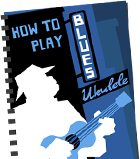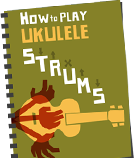New Releases
– Debut solo record from Tobias Elof: Ukulele Meditation. As the title suggests, it’s more contemplative than his usual rapid-fire playing. But a very beautiful album.
– Tasty Ukulele Songs by Crispy Jones
Videos
– The excellent PBS/BBC series American Epic (covering the earliest folk and roots music of the USA) has included some excellent performances by modern artists. Notably The Hawaiians covering Tomi Tomi after the legendary Sol K Bright version.
– The Bandrum: A New Folk Instrument Kickstarter Video: made for banjo but would be effective on ukulele too.
Window Shopping
– 1930s Favilla Painted Soprano Ukulele.
– Cheezy bass ukulele.
– Hibiscus pick guard.
– Pelem ukulele.
Radiohead – No Surprises (Tab)
I may have to return to OK Computer for another tabbing or two. Every song on the record is incredible. But No Surprises stuck out as the one that’s prime for a ukeing.
In this arrangement I’ve tried to keep the fingerpicking riff going under the melody. Which works out pretty well for the most part. But you really do have to make sure you emphasise the melody notes or they can very easily get lost in the picking.
Towards the end I switch towards strumming. To make the melody easy to see I’ve tabbed up the backing strums as just being on the g, C and E strings. But it’s not a big deal if you hit all the strings.
Links
A guest post today from Joshua Waldman. As well as leading the Tigard Ukulele Group he has just released a book How to Start and Grow a Ukulele Group (available in digital and paper form (affiliate links)). It’s by far the most comprehensive and inspiring I know of. Highly recommended if you’re starting or running a ukulele group.
When I started the Tigard Ukulele Group (TUG), I had no interest in leadership. I work for myself in a home office. My business is online and I don’t have a team to manage, nor do I have a boss to worry about. I’m not trying to be a better boss or climb some corporate ladder. What does leadership have to do with me?
Turns out, I found an answer to that question very quickly! Running an ukulele group has been one of the greatest personal growth journeys I’ve ever undertaken.
What I learned is that being a leader requires you to find your self-confidence, own the room, make decisions and take risks. It also means potentially making public mistakes and embarrassing yourself. But it also means being someone that others can rely on, being the beacon that guides people, of taking the initiative on fun and inspiring projects.
You make the call
When I first started TUG, we went around in a song circle. Everyone brought their own songs and some extra copies to pass around. This worked fine for the first few weeks and when we had around seven people in my living room. However, as we grew, the song circle format fell apart. Songs bombed. We ran out of music to play.
So the next time we met, I told them what we were playing. “Here’s our song list.” I remember feeling totally surprised that everyone agreed to this. Looking back, this makes sense, they came to play music, not lead a group. That was my job. Even now, at potlucks and parties, when I ask the group what they want to play they look back at me and say, you tell us, we’ll follow.
A few years ago, we were preparing for our very first concert and used our jam sessions to practice songs on our setlist. Our focus was to get into songs and out of songs at the same time. For weeks, we played the same songs over and over again. The concert happened. It went great! And I kept up the practice of repeating songs that needed more work.
After a while of this new format, I checked in with the group to see if they were getting tired of this. To my surprise, everyone really appreciated it. This format continued naturally, even after the concert. In fact, to this day, if a song could have gone better, and I’m about to flip to the next one, members will ask to repeat it, “just one more time.”
You are the leader of your group. You make the calls. Stop looking for approval or consensus. It’s not you imposing your will on others. It’s you offering others the chance to relax and just follow along. Leadership is service to others.
Own your mistakes
We were working on a difficult and highly orchestrated song at TUG one time when a longtime member who hadn’t been for a while showed up. She hadn’t been there the previous two weeks while we were working on this. When she raised her hand and offered some suggestions that would have radically changed what we’d been doing for weeks, I shut her down. “It is the way it is. No more changes,” I said and then watched as she shut down, stopped playing and her body folded in on itself.
I immediately realized my mistake, having gotten so intensely focused on getting the song right that I forgot that we were there to have fun! After the session, I went up to her and apologized. Although she shook it off, said it was no problem and changed the subject, I could tell she appreciated the apology.
Leadership isn’t always easy. But it does make you a better human being as long as you learn from your mistakes.
What I learned from leadership
What I learned is that leadership is a very personal journey. It’s a mirror for your own limiting beliefs, low self-esteem, self-doubt and fears. One of the greatest benefits of having started this group has been the chance to face these parts of myself and deal with them and then grow as a person.
Leadership is an interesting thing. In an age that seems to value collaboration and groupthink as ultimate ideals, apparent leadership seems to be based on how rich you are or how many likes you get on social media posts. I think this is a sad waste. Everyone has leadership potential. Despite our media, human nature is human nature, and groups of humans seek out a leader to represent them. The world isn’t run on consensus or on who has the most likes.
Joshua Waldman is the founder of Tigard Ukulele Group and had just published a book called, How to Start an Ukulele Group where you can find more stories and thoughts on ukulele group leadership.
Radiohead – Lift (1996 Version) (Chords)
It’s the 20th anniversary of Radiohead’s OK Computer and they’re releasing an expanded version with outtakes including long-time fan favourite Lift. I had to write it up in anticipation. The chords are based on the incredible 1996 version rather than the dreary, and not in a good way, 2002 version.
Weirdly, between starting on this song and posting it I got stuck in a lift. I didn’t have an existential crisis but I did find out that button that’s supposed to call for help does nothing. Which is a metaphor of its own.
The song is in the key of B so I’ve made it more uke-friendly by putting a capo on the second fret.
Suggested Strumming
I like to use this as the main strum:
Intro: Main strum four times.
Verse: Main strum three times on A, twice on A7, once on F#m. On the D play the main strum once first time around and twice second time around in each verse.
Which goes like this:
Chorus: There’s a bar of 2/4 in the chorus which makes the strum pattern a little tricky.
Play the main strum three times on A. Then the 2/4 which I play d – d – d u d u. After that it’s the same as the verse except the D is always played only once.
Which sounds like this:
Twiddly Bits
Here’s a tab of the little riff that pops up in the verses starting on the A7 chord. It’s tabbed without the capo.
Links
In the Movies
– Graham Jones’s film Sunshine Ukulele is about, “the impact of the internet upon music and movies.” Which makes the ukulele a perfect subject for it. You can watch the whole thing free on YouTube.
– Zarha Lowzley’s scene playing her uke in Trainspotting 2.
Window Shopping
– Lichty Archtop U121.
– Ko’olau 20 year anniversary tenor.
– A pair of vintage Washburn sopranos from 1922 and from 1930.
– KoAloha KSR-0000 soprano.
New Releases
– The Poor Boys of Worcester have a new album of spirited country, blues and hokum songs Hard Luck Songs for Hard Working People.
Follow Up
– The Art on a Ukulele campaign to raise money for The Hepatitis C Trust finishes at the end of today (Friday).
– Deaf ukulele player, Mandy Harvey has entered America’s Got Talent and won over Simon Cowell.
alt-J – Fitzpleasure (Tab)
There’s a new alt-J album out. And very good it is too. To celebrate here’s a tab of my favourite alt-J song Fitzpleasure.
There’s a lot going on in this song (as with most alt-J songs). At first I thought I’d have to use multiple ukes to do it. But the melody, chords and riffs are all so strong and elegant they ended up working pretty well on just one uke. The only major part I had to cut was in the, “steepled fingers…” section. The descending riff in bars 59 and 60 should carry though there but I had to switch to chords to carry it off.
I use a capo on the second fret for my version. But that’s only because it makes it in the original key so it was easy for working it out. You can play it without the capo without causing any problems.
Links
Old Crow Medicine Show – Wagon Wheel (Chords)
What a brilliant song. And one that’s very popular with uke groups. It started life as a half-written Bob Dylan song called Rock Me, Mama before OCMS finished it up and launched their career with it. It’s been covered many times since with Darius Rucker‘s being the most popular.
Like the original, I’m using a capo on the second fret. It’s not essential but it does make the chords much easier and avoids the dreaded E chord.
Suggested Strumming
You can use this simple pattern all the way through:
d – d – d u d u
Use that once for every chord until the last C in the progression where you play it twice.
Here’s how it sounds:
Twiddley Bits
Intro and Outro (Tab)
Here’s an arrangement of the violin part in the intro (which starts four bars into the song). Again, there’s a capo on the second fret.
The example finishes up with the violin lick in the outro.




